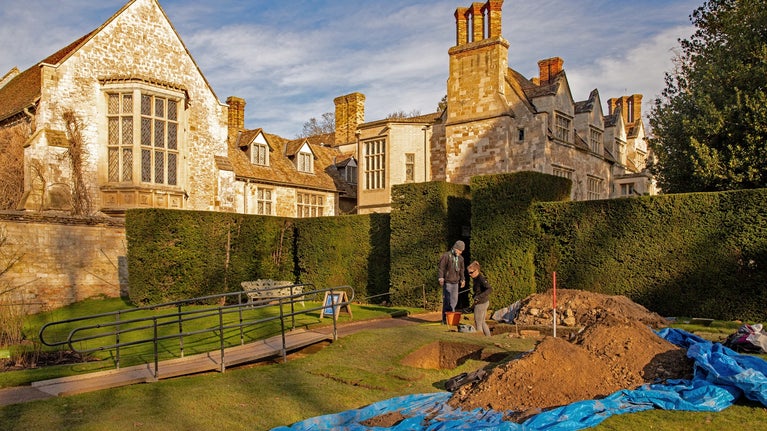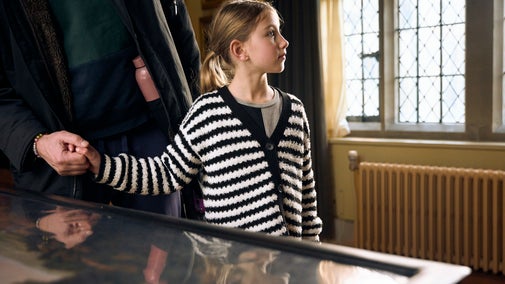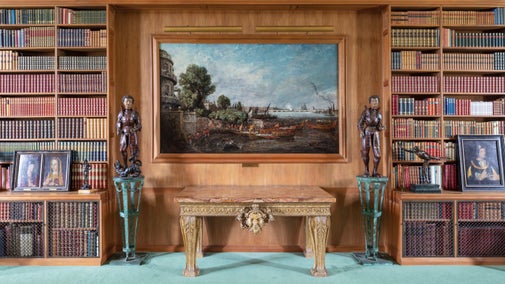
Donate
Everyone needs nature, now more than ever. Donate today and you could help people and nature to thrive at the places we care for.

Archaeologists from the National Trust and Oxford Archaeology carried out a dig to investigate the medieval history of Anglesey Abbey. Delve deeper into the project and what was found.
In January 2024, Oxford Archaeology conducted a dig in the Rose Garden at Anglesey Abbey to see if they could gather new evidence about the medieval priory and trace the priory church wall in the nave area.
Due to the global coronavirus pandemic, the dig on the front lawn came to an abrupt halt in 2020 and the planned dig in the Rose Garden never went ahead... until now!
This year at Anglesey Abbey, the gardening team have extended the Rose Garden by 20 new beds, 19 additional rose cultivars and some 180 roses which have been generously donated to the gardens by David Austin Roses.
Before marking up the new rose beds and planting the roses, our archaeologists, alongside Oxford Archaeology, conducted the dig in order to ensure that the extension of the Rose Garden wouldn't damage any of the surviving walls.

The test pits were positioned to assess survival of buried remains associated with the medieval priory church and adjacent priory complex and anything relating to the later conversion of the monastic house into the house we see today.
The ground level of the Rose Garden lawn drops by some 30cm and so, test pits were located to assess what, if any, remains survived within the projected line of the medieval church walls as the geophysical results in this area were not conclusive. Aside from the main find, some fragments of post-medieval tobacco pipes and pottery were also dug up in the process...
The test pit in the centre of the Rose Garden lawn revealed a thick deposit of demolition material including what is considered to be remains of demolished medieval fabrics (chalk and clunch rubble) mixed with later demolition materials. A compacted layer was also noted in this test pit and could indicate the levelling surface of a floor – perhaps the aisle of the nave of the church, which would have had stone or tile paving originally overlaying it. But it was the test pit located in the north-east corner of the Rose Garden lawn that caused quite the stir.
In this test pit, slightly hindered by an electrical service cable, the remains of a very large medieval wall foundation were uncovered. The limitation of the test pit location meant that the full extent of nature of this wall foundation could not be ascertained, however through extending the test pit as much as possible in the area, the wall was revealed to be 1.3m wide and more than 2.6m long, with a depth greater than 0.3m. Bounded by lime mortar, the irregular clunch and chalk blocks were similar to the medieval demolition material found in other test pits and in the 2020 trenches but no faces or dressed stone blocks were found in this or any of the other test pits.
Despite only partial exposure of this wall, its scale suggests the foundation could easily have supported two storeys. The location does not quite seem to line up for a west end church tower feature or buttress and interestingly, this large wall remnant was not picked up in any previous geophysical surveys!
Overall, the remains of sections of the medieval church and adjoining priory complex are well preserved, however, as with many partial excavations, we have more questions than answers! Also, we know that whilst areas of wall foundations have been identified through the non-intrusive surveys, large wall remains have not! Hence, the mysteries of the priory church are still very much unresolved but tantalisingly within our reach through future research and investigation.

We carried out a targeted programme of archaeological survey and excavation in March 2020. A series of small test pits were dug by hand on the lawn, in front of the south face of the house.
The project began on 16 March 2020 and unfortunately coincided with the global coronavirus pandemic. As a result, we reduced the number of trenches we opened, managing to hand excavate two of those originally planned, and cancelled the programme of visitor tours, talks and activities.
We worked together with Oxford Archaeology to react quickly to the changing situation and ensure the safety and wellbeing of staff, volunteers and visitors. The dig was stopped earlier than planned on the 24 March 2020.
The aim of the investigation was to better understand the early development of the site as a medieval hospital and Augustinian Priory. Geophysical survey and parch marks identified from aerial photographs had revealed the outline of buildings which appear to be the priory church and cloister, believed to have been built in the 13th century.
Along with information from documentary records and prior geophysical and earthwork surveys, this new evidence will be used to inform our understanding and future interpretation of Anglesey Abbey’s origins and development.
The first trench was situated to investigate the possible chantry chapel at the east end of the church. The eastern wall of the chapel was found at a shallow depth and appears to have been supported by a large buttress at its south end.
Several pieces of stained-glass window were found, suggesting that there was a decorated window at the east end of the church. Other medieval finds included small fragments of moulded clunch, possibly part of the window tracery, and fragments of lead and iron nails, also possibly associated with the windows.
The chapel wall, thought to date to the 13th century, was sealed beneath the foundations of an 18th century garden wall and beside this was the complete skeleton of a dog. The dog burial post-dates the wall and is likely to have been a pet laid to the rest in the garden in recent centuries.
However, at the south end of the church, the medieval wall appeared to stop. Did it turn? Was there an entrance way suggesting the east end had been extended or altered? Or was a huge section of the wall simply completely removed in later years?
In the second trench, we found evidence for what may be the cloister walkway and the north wall of the church. However, as we had only just started to expose the remains in the second trench, there are more questions! If the curved section is in fact a stair, is it leading to the cloister walk or are we still inside the church?
More stained glass, and a piece of decorated floor tile, were found in this trench. The discovery of a large pillar base which may have been the support for a rising stone staircase, hints that the night stairs, leading from the dormitory to the church transept, were also located here.
There was also evidence for the 17th and 18th century occupation of the house, with wall remnants associated with a garden as well as a padlock, possible Delftware pottery, Champagne bottle fragments and the remains of a set of 18th century scales, presumably thrown out from the kitchens when the gardens and house were remodelled.
It’s clear the medieval remains beneath the lawn are more complex than we’d previously thought and survive in relatively good condition. We also suspect there’s a huge amount more to learn just in these two small trenches.
For example, in the east end wall trench, we’d just started to expose an earlier layer of demolition material on the internal side of the wall, which could indicate that medieval floor surfaces survive beneath this. But for now, these artefacts and the church walls remain safely hidden in the ground, waiting for the day that we can investigate the site further.
All the exposed building remains have been recorded and left in-situ, and the trenches have now been back-filled and the front lawn restored.
This project has given a fascinating insight into the layout and appearance of the priory church, as well as the later use and remodelling of the private residence and gardens of Anglesey Abbey. This information will inform future interpretation, storytelling and research. We look forward to exploring options to continue this research in the future.
A huge thank you to everyone who supported the dig and especially in 2020, to those who adapted to the changing circumstances to ensure we could all stay safe and well. We’d originally planned to work with volunteers from Operation Nightingale, but the situation meant they were needed elsewhere.
In 2020, we were able to draw on last minute support from local amateur archaeologists through Jigsaw Cambridgeshire and when this was no longer possible the team here at Anglesey Abbey stepped in to dig, shift soil, and push wheelbarrows. Every person involved brought their enthusiasm to the excavation and for many it was a moment of fascinating escape in very strange times.
Oxford Archaeology, based just outside Cambridge, carries out commercial archaeological fieldwork in advance of development as well as research and community projects. Oxford Archaeology have worked on various projects at Wimpole for over 30 years, including the excavation at Lamps Hill in 2018.

Everyone needs nature, now more than ever. Donate today and you could help people and nature to thrive at the places we care for.
Discover the many layers that Anglesey Abbey and Mill has to offer and explore the long and fascinating history that stretches from 12th-century priory to 20th-century home.

Discover the many layers that Anglesey Abbey has to offer. A Jacobean priory, once home to Lord Fairhaven.

Plan your next family adventure at Anglesey Abbey.

We believe that nature, beauty and history are for everyone. That’s why we’re supporting wildlife, protecting historic sites and more. Find out about our work.
